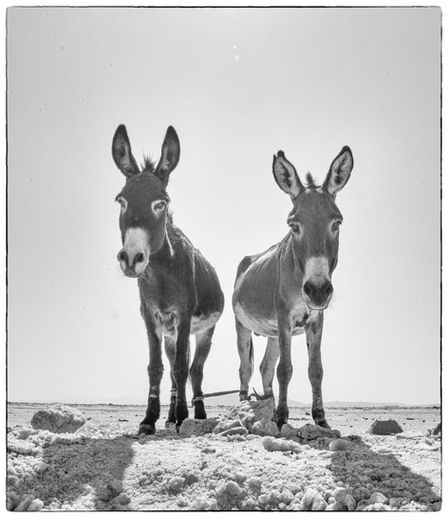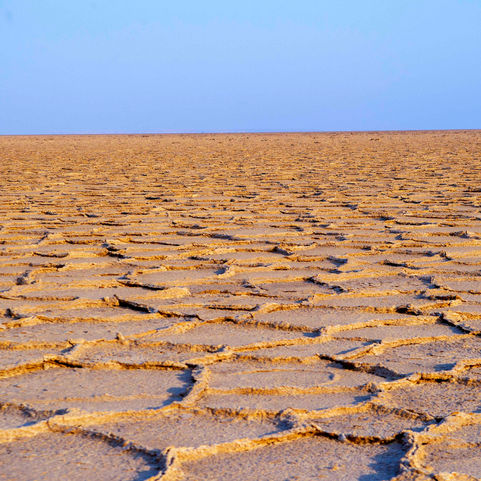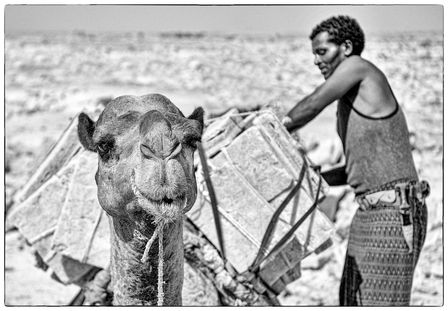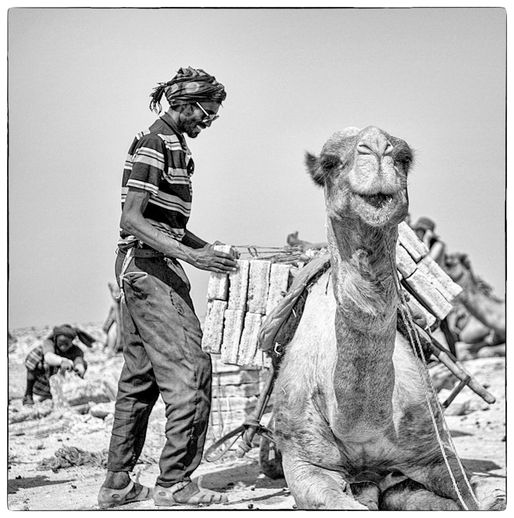The many roads in the Danakil are just sand and lava tracks leading through a strange wilderness, a bleak road ahead and travelling through this area requires a four-wheel drive jeep, lots of water, and your repair equipment. A guide who knows the area is a must, and armed guards are advised in certain areas where the danger of tribal attacks is said to occur.
Starting from the town of Wikro on a four-wheel drive convoy, we made our way down the rough terrain of a windy mountainous road, travelling across the Ethiopian portion of the Great Rift Valley until we reached our destination.

It was crazy leaving the city behind.

Then, as the road became narrower, massive dried-up valleys and canyons gave place to empty baron country.

The next Morning after the military permission, we were all grouped as a convoy.
I’ve reached the land that has gained many names for death and heat. The heat is almost unbearable, and I can barely lick my lips to speak. Nights are considered on a scale of 1 to 10 as 1% cooler than the day. I am yet to experience the day. I am travelling by foot on a 6-mile walk in the inky blackness of the night to capture the burning hot lava of hell.
After my long journey to reach this place, I finally settled down and tried to figure out the best position for my camera. The men who are to be my guides on this journey tell me that this is truly the ‘Gateway to Hell’ and the hottest place on earth, daily recording temperatures of 125 degrees.
I am at the Erta Ale, which means ‘smoking mountain.’ Erta Ale, at 613 metres (2,011 ft) in height, is accounted for having 1 or 2 active lava lakes at its summit that overflow on the south side of the volcano, spewing lava out of the mouth of the volcano. Erta Ale is noted for having the longest-existing lava lake in existence since the beginning of 1906. Volcanos with living lava lakes are very, very rare, and I feel my own rush of adrenalin at the sight of this world wonder that is counted among one of only eight living lava lakes in the world. Erta Ale is centred over the East African Rift system - a triple junction setting that has resulted in the formation of a pull-apart basin or rift.
Day 3
After reaching the base of Erta Ale, the Camels rest beneath the heavenly blue sky on a moonlight night

The last stop for food and water before travelling east into the depression is the small settlement of Hamad-Ile, which is located on the verge of the desert.


From its base to the summit, the 6-mile walk doesn’t seem so bad to me now, for the night is relatively cool and watching the scary yet, the breathtakingly beautiful lava lake in the active shield volcano spewing and coughing up flames and molten lava is amazing. Gazing at the bright orange of the hot lava tinged at the edges with bright yellow gold against the pitch-black darkness of the night and our surroundings emphasises why it bagged such a name, and its close connection to hell or what we imagine hell to be.

Searingly hot temperatures rise and swarm in the midst of that hot lake, and my effort is well worth the heat I endured, but I am yet to experience tomorrow as I spend my night on that summit.
Morning dawns as hot and searing as yesterday, if not more. Today, I can see why travellers say this is almost an alien land. The ground I tread on is a mass of yellows, oranges, reds, blues and greens that I understand are due to the rain and seawater from the nearby coasts that seep through into the sulfuric lakes and once heated up, the salt from the sea reacts with the minerals in the magma, resulting in these dazzling colourful crust-like deposits that develop across the land, which mix mystically with the cooler deep blue and turquoise lakes in the depression.

Day 4: Moon lit night

Day 5: Sunrise over the Danakil
As I wander over the crusty surface of Dallol, which sits at 150 feet below sea level and is formed by the eruption of craters, I really cannot believe such places on earth exist. These are the lowest and hottest spots on the planet, full of geysers and acid ponds. The scarcity of the most precious commodity – water is its greatest problem. We stop at one of the few springs-wells where all tourist groups and the Afar people, passing through on their way to Erta Ale and Dallol, have to depend.


The Afar People
The Afar people come to mine salt at Lake Assal. It is their only means of living. The salt lakes boast a vastness of raw beauty. The effects created when the salt is covered with water are an outstanding masterpiece of unbelievable formations. The Afar miners mine the salt by hand, and then it is transported by the famous Salt Caravans that stretch for miles as they travel. The camels were bearing heavy loads of 6 to 6.5 pounds, blocks strapped to their bodies on either side as they walked through the desert for three days. Whole families are involved in this salt trade and transporting of the salt from salt deposit sites to the road, which accommodates motorised vehicles.



Each day, Afar miners chop salt from the earth under the hot sun, then load the minerals onto camels and donkeys, and march for days to market towns.
I love this feeling of spectacular empty nothingness. The salt caravans moved in slow but in formation and silent, cutting across the whiteness of the cracked, barren desert. I sat there for hours as they passed me by thousands of slabs of salt, each stacked up high.
This Must be God’s Greatest Canvas
This This must be God’s greatest canvas, I think, as I am amazed by the sheer greatness of my surroundings, for by day, this land tells myriad colourful tales. The combination and structure of what is known as the Hottest place on Earth, hidden amidst the northeastern corner of Ethiopia, are born of the strange composition of copper, salt, sulfur and acidic pools. The sulfur and salt create more neon yellow shades, and the cooler copper-laced pools show up as turquoise in colour.
Danakil Depression is by far one of the most incredibly beautiful natural wonders in the world - I have ever seen. I have been to many locations around the world, and this is a scarily strange place. An immense sense of solitude begs to hide its scary assets. PH levels are such that it is not advisable to dip a finger in that glorious deep blue pool or touch certain areas of the acid-prone sections of this Earth. It is one of the most alien places on Earth, and yet it is Ethiopia’s growing attraction as a destination.







I am told that scientists, miners and travellers throng to see this land with its surreal bubbling pools, hot springs and weird land formations.

By far, this has been an extraordinary journey, and as I gaze at the lemon greens and luminous yellows that hold my full attention, nothing short of a poetic verse can justify such splendour. Seas of greens, golds and oranges dotted with masses of small rock formations that take on shades that are not the norm, amidst masses and masses of wave-like contours edged with mirrored details of flotsam that swirl in and out in a grandeur that meets the eye - lie in all directions, from where I stand.
The Danakil Depression is an oxymoron for, while the scorching heat can’t be overlooked, the beauty overrides its name, and this part of the earth earns a visit.








